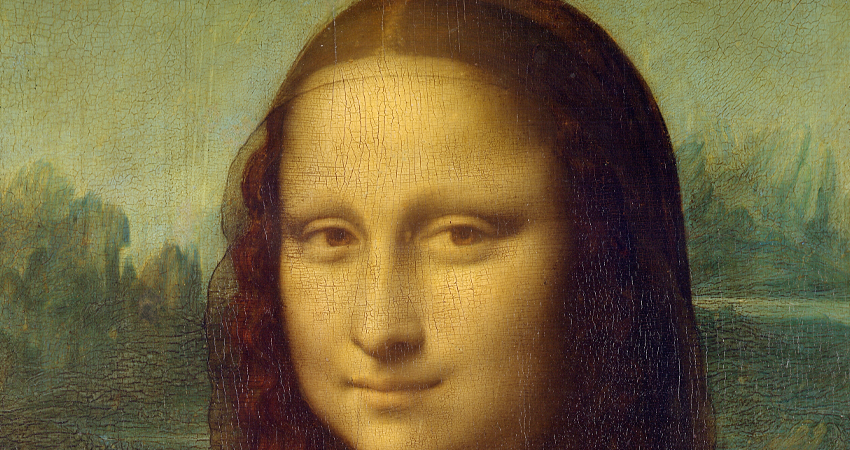
The Mona Lisa: Five Fun Facts About Leonardo Da Vinci's Masterpiece
Giacomo CrosettoShare
The Gioconda, or Mona Lisa, is one of the most famous and mysterious paintings in the world. This work of art, created by Leonardo da Vinci between 1503 and 1506, is admired for its technical perfection, psychological complexity and the enigmatic smile that characterizes her face. Despite having been studied and discussed for centuries, the Gioconda continues to raise questions and curiosities. Let's look at five of the most fascinating aspects of this masterpiece and why it continues to capture the collective imagination.
The Mystery of the Smile
One of the distinctive features of the Mona Lisa is her enigmatic smile, which appears sometimes sweet, sometimes serious, depending on the angle from which it is observed. This expressive ambiguity is made possible thanks to the sfumato technique, one of Leonardo's technical innovations. The sfumato consists of delicately blending the contours of the figures, especially around the mouth and eyes, to create an effect of gradual transition between the different shades of color. The technique allows the observer to perceive the Mona Lisa's expression differently depending on the distance and perspective.Psychological and optical insight
The perception of this changing smile has been analyzed by psychologists and neuroscientists, who have found that our mind can interpret the same expression in different ways. According to some research, peripheral vision tends to perceive a more pronounced smile, while direct vision seems to return a more neutral expression. This makes the Mona Lisa's face appear to constantly change, adding an element of mystery that has fascinated scholars and admirers for centuries.
The Theft of 1911
An episode that contributed greatly to the fame of the Mona Lisa was the theft that occurred in 1911. On the morning of August 21, the painting disappeared from the Louvre, taken away by Vincenzo Peruggia, a former employee of the museum. Peruggia, convinced that the painting had been stolen by Napoleon during his campaigns in Italy, claimed he wanted to return the work to its "native land". For two years, the painting remained hidden in his modest home in Paris.The Arrest of Perugia and the Public Reaction
When the painting was recovered in Florence, where Peruggia was trying to sell it to an antiques dealer, the theft became an international media case. Paradoxically, instead of being despised, Peruggia was seen by many Italians as a patriot and defender of cultural heritage. Despite his conviction, his action helped fuel the legend of the Mona Lisa, increasing worldwide interest in the work.
The Small Size of the Painting
First-time visitors to the Louvre are often surprised by the relatively small size of the Mona Lisa. At 77 cm high and 53 cm wide, the painting is smaller than one might imagine, given its global fame. This characteristic has a surprising impact, as it contrasts with the symbolic and artistic value of the work, which occupies an imposing place in the history of art.Why did Leonardo choose such a small format?
The use of a small canvas can be traced back to a taste of the time for intimate portraits, intended for private residences. Furthermore, Leonardo probably intended to focus on details and psychological introspection rather than on a monumental representation. The work is therefore conceived to be observed up close, a detail that, in the context of the Louvre, creates a unique but also, often, crowded visual experience.
The Identity of the Mona Lisa
The figure portrayed is traditionally identified as Lisa Gherardini, wife of the Florentine merchant Francesco del Giocondo, hence the title "Mona Lisa". However, this identification has never been completely certain, and the hypothesis has undergone various revisions over the years. Some scholars suggest that it could be an ideal of female beauty created by Leonardo himself, others that it could be a synthesis of several faces.Alternative theories
A more daring theory is that the Mona Lisa may be a masked self-portrait of Leonardo da Vinci. This would explain the ambiguity of the expression and the fascination exerted by the androgynous image, neither completely feminine nor masculine. Although unconfirmed, this hypothesis continues to attract enthusiasts and scholars, demonstrating how the face of the Mona Lisa remains an open enigma, a symbol of the psychological complexity of the human being.
The Protection of the Mona Lisa
Today, the Mona Lisa is kept in a special bulletproof glass case inside the Louvre, equipped with a temperature and humidity control system. This level of protection is due to the painting's unparalleled popularity, which attracts millions of visitors each year. The case serves not only to protect the work from possible vandalism, but also to preserve it from the effects of time and environmental changes caused by the constant flow of people who pass by the painting.Accidents and attempted vandalism
Over the years, the Mona Lisa has been the victim of various attempts to damage it. In 1956, a visitor threw a stone at the painting, slightly damaging the underside; it has since been further protected and isolated. The glass case allows anyone to observe the work up close, but limits direct interaction, creating a sort of "emotional barrier" between the observer and the work, almost as if the painting were consciously detached and inaccessible, perpetuating the aura of mystery that surrounds it.

